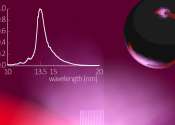Laser-produced uranium plasma evolves into more complex species
When energy is added to uranium under pressure, it creates a shock wave, and even a tiny sample will be vaporized like a small explosion. By using smaller, controlled explosions, physicists can test on a microscale in a safe ...









